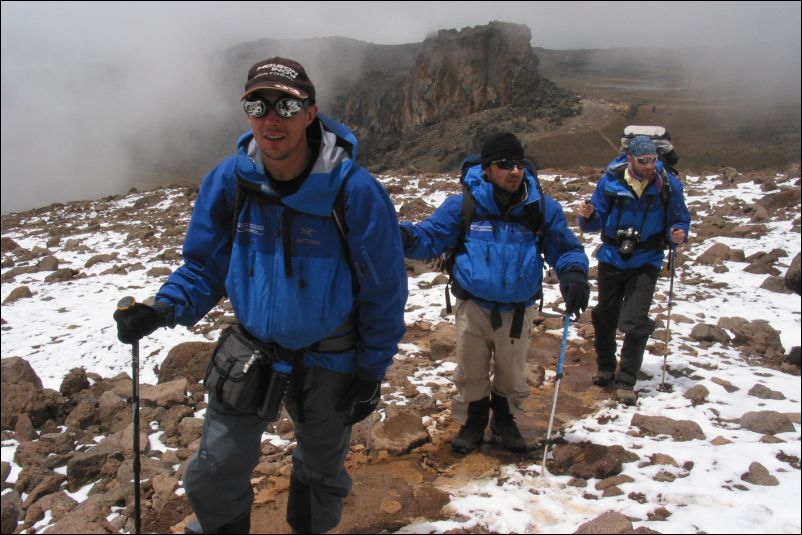There is a good chance during a trek in Tusker country it will rain or snow. Most adventure travelers gear up to stay warm paying less attention to staying dry. Big mistake because getting wet especially in cold conditions can compromise your health (hypothermia) jeopardizing your ability to finish the trip.
We have always subscribed to the cliché — there is no bad weather, just bad clothing. The first two rules of backcountry attire is leave cotton at home and seek the best water proof clothing you can afford.
How wet is it going to be?
We wish we could give you an accurate weather prediction for your upcoming trekking trips to Kilimanjaro’s summit, Nepal’s Everest Base Camp, Mongolia’s Altai Tavn Bogd and Chile’s Torres Del Paine, but in good conscious we can’t. Based on previous trips to these mostly blue sky destinations there has been some rain, snow and wind.
Patagonia is the most unpredictable and Tusker’s South American guide Andrew Springsteel describes days that start in sun then the wind whips and for the next two hours rain hits you from all sides.
“You’re at the tip of the South American continent and weather is quite variable. Yvon Chouinard built kick-ass gear and if you know Patagonia gear you realize where it came from,” Andrew said. Chouinard climbed some of the highest peaks in Torres Del Paine in the 1960s and his outdoor clothing company Patagonia continues to set the bar for quality clothing and gear.
In both Patagonia and Mongolia you can have misty rain in the morning and bright sun by afternoon. In Nepal’s Himalaya you can be hiking in shorts at lower elevations, but get hit by a snow storm at high elevation on either the spring or fall trips. With weather becoming increasingly capricious in a globally changed climate you must come prepared with clothes/boots for the wettest conditions and hope you never have to test them.
Watery wardrobe
There has been a revolution in water proof technology the last decade and this has made it easier to stay dry in the backcountry. Still if you’re walking through creeks or boggy trails there is a good chance you will get wet. That’s not a disaster because on all three Tusker destinations you can put your wet boots by the fire to dry out overnight in Kilimanjaro’s kitchen, Torres Del Paine’s refugios, Nepalese tea houses and Mongolia’s Gers.
Many adventure travelers have discovered the big difference between water resistant and water proof boots, but that’s no guarantee of staying dry. Just because you bought the $200 plus water proof boots you can go on automatic pilot. Find out how to keep your boots protected so they can provide max protection against snow and water. Your old faithful leather boots need new coats of a bees wax sealant such as Kiwi Camp or Obenhauf’s Heavy Duty Crème or the old stand-by Sno-Seal. Newer Gore-Tex boots need to be periodically sprayed to keep them water tight or touched up with Nikwax.
Unless you live and recreate in the Pacific Northwest chances are you are not that invested in the best rain gear. Backpackers and long distance hikers there know about leak points and the importance of internal ventilation. It’s not just about gear, but about the science of water VS man made materials and this is not a static subject. These Northwestern backpackers do deep dive research to find the best boots, rain shells, pants, rain hoods and packs. You should too by reading the latest comparison tests done by reputable outfits like OutdoorGearLab. Always know as much or more about clothing and boots than the friendly sales people at your local outdoor store.
Tusker’s take: Level Two
Tusker recommends for all trips that rain jackets and rain pants should be in mid-range weights or Level 2. A level 1 rain jacket is something you wear on a golf course and a level 3 is what you take to the top of Mt. Everest. Level 2 is more comfortable, lighter and costs much less than the level 3 jackets that are more durable, but stiffer. Jackets rated 2 and 2.5 are perfect for layering and that is a key component to staying both dry and warm on Tusker trips. Andrew recommends you carry both a silk and soft merino body inner layer below your water proof shell layer.
When considering rain paints and jackets remember that on the Patagonia trek there are no porters and you must carry your own pack. Weight is a critical component on this trip as it is on other Tusker treks where porters bear the weight burden.
Andrew recommends you have a stellar rainproof cover for your pack as well as a top notch rain hood on your jacket. The hood should have a brim that keeps water out of your glasses as well as a draw string to assure a tight fit. Be sure to check your boot laces before the trip, Andrew advises. If your laces break on the trip this will compromise fit and make it easier to both blister and get wet. Also a trekking pole is a big asset in wet conditions helping you navigate slippery rocks, assessing creek depths and getting across snow fields.
Trailblazer
Hiking with an umbrella makes you a wimp, right? No, it makes you smart.
Tusker founding guide Eddie Frank started hiking with an umbrella in Kilimanjaro’s low level rainforests and discovered they were a great way to keep both the rain and sun off. He carries an umbrella on all trips because of added protection plus their portability.
If you sweat going uphill in the rain in a rain jacket it can defeat its purpose. With an umbrella you have better ventilation plus it always serves as a mini-shelter. In treeless terrain, many hikers have used an umbrella for privacy when they need to pee.
Get yourself a waterproof pair of black gloves and a solid backcountry umbrella. Don’t worry if others call you a wuss. Chances are they will want to borrow your umbrella because you are drier than they are.
Pray for rain
Nature is never more beautiful and photogenic than when you’re in unsettled even stormy conditions. The light is ethereal; the contrasts between green forest and gray rock faces are often dramatic in the mist. Rainbows and lightning are a photographer’s chance to get the image of a lifetime.
If you’re buttoned down to stay dry you can see this beauty and fully embrace it. Pushing forward with positivity on a rainy backcountry day requires both a mental and physical adjustment. It requires effort to find the right gear then making sure it’s been maintained with proper coatings and care.
Once you’re confident in your gear and clothing, throw yourself into nature’s Olympic size pool then trek like crazy.
Ready to Explore?
Tusker Trail was founded in 1977 with Eddie Frank’s first trans-Africa expedition. Today, 45 years later, Tusker Trail is recognized across the globe as a world class, expedition company with an incredible track record and reputation for training the finest guides on the planet. On Kilimanjaro, Tusker’s mountain guides have earned the nickname “The Lions of the Mountain” by guides from other companies.
Take a look at Tusker’s treks, each a unique experience of some of the most amazing journeys that will challenge you and change your life forever. If you have a question about our treks give us a call +1.775.833.9700 or 1.800.231.1919 and if you talk to Eddie Frank be sure to ask him about the bet he made 45 years ago that sent him on that first expedition across Africa.
TUSKER TRAIL TREKS
Kilimanjaro Climb – (Tanzania)
Everest Base Camp Trek – (Nepal)
Mongolia Nomad Trek – (Mongolia) – “Trip of the Year Award: Outside Magazine”




